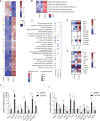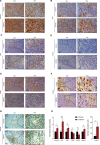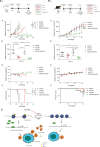Immune modulation underpins the anti-cancer activity of HDAC inhibitors
- PMID: 33773029
- PMCID: PMC8637571
- DOI: 10.1002/1878-0261.12953
Immune modulation underpins the anti-cancer activity of HDAC inhibitors
Abstract
Aberrant protein acetylation is strongly linked to tumorigenesis, and modulating acetylation through targeting histone deacetylase (HDAC) with small-molecule inhibitors has been the focus of clinical trials. However, clinical success on solid tumours, such as colorectal cancer (CRC), has been limited, in part because the cancer-relevant mechanisms through which HDAC inhibitors act remain largely unknown. Here, we have explored, at the genome-wide expression level, the effects of a novel HDAC inhibitor CXD101. In human CRC cell lines, a diverse set of differentially expressed genes were up- and downregulated upon CXD101 treatment. Functional profiling of the expression data highlighted immune-relevant concepts related to antigen processing and natural killer cell-mediated cytotoxicity. Similar profiles were apparent when gene expression was investigated in murine colon26 CRC cells treated with CXD101. Significantly, these changes were also apparent in syngeneic colon26 tumours growing in vivo. The ability of CXD101 to affect immune-relevant gene expression coincided with changes in the tumour microenvironment (TME), especially in the subgroups of CD4 and CD8 tumour-infiltrating T lymphocytes. The altered TME reflected enhanced antitumour activity when CXD101 was combined with immune checkpoint inhibitors (ICIs), such as anti-PD-1 and anti-CTLA4. The ability of CXD101 to reinstate immune-relevant gene expression in the TME and act together with ICIs provides a powerful rationale for exploring the combination therapy in human cancers.
Keywords: HDAC inhibitors; checkpoints inhibitors; immunotherapy; tumour microenvironment.
© 2021 The Authors. Molecular Oncology published by John Wiley & Sons Ltd on behalf of Federation of European Biochemical Societies.
Conflict of interest statement
The authors declare no conflict of interest.
Figures





Similar articles
-
HDAC Inhibition Upregulates PD-1 Ligands in Melanoma and Augments Immunotherapy with PD-1 Blockade.Cancer Immunol Res. 2015 Dec;3(12):1375-85. doi: 10.1158/2326-6066.CIR-15-0077-T. Epub 2015 Aug 21. Cancer Immunol Res. 2015. PMID: 26297712 Free PMC article.
-
Pharmacological activation of STAT1-GSDME pyroptotic circuitry reinforces epigenetic immunotherapy for hepatocellular carcinoma.Gut. 2025 Mar 6;74(4):613-627. doi: 10.1136/gutjnl-2024-332281. Gut. 2025. PMID: 39486886 Free PMC article.
-
Regulating Histone Deacetylase Signaling Pathways of Myeloid-Derived Suppressor Cells Enhanced T Cell-Based Immunotherapy.Front Immunol. 2022 Jan 24;13:781660. doi: 10.3389/fimmu.2022.781660. eCollection 2022. Front Immunol. 2022. PMID: 35140716 Free PMC article. Review.
-
Checkpoint regulator B7x is epigenetically regulated by HDAC3 and mediates resistance to HDAC inhibitors by reprogramming the tumor immune environment in colorectal cancer.Cell Death Dis. 2020 Sep 15;11(9):753. doi: 10.1038/s41419-020-02968-y. Cell Death Dis. 2020. PMID: 32934224 Free PMC article.
-
Targeting pancreatic cancer immune evasion by inhibiting histone deacetylases.World J Gastroenterol. 2022 May 14;28(18):1934-1945. doi: 10.3748/wjg.v28.i18.1934. World J Gastroenterol. 2022. PMID: 35664961 Free PMC article. Review.
Cited by
-
HDAC inhibitors enhance the anti-tumor effect of immunotherapies in hepatocellular carcinoma.Front Immunol. 2023 May 26;14:1170207. doi: 10.3389/fimmu.2023.1170207. eCollection 2023. Front Immunol. 2023. PMID: 37304265 Free PMC article. Review.
-
MS275 induces tumor immunosuppression by upregulating PD-L1 and enhances the efficacy of anti-PD-1 immunotherapy in colorectal cancer.Cancer Immunol Immunother. 2025 Mar 17;74(5):150. doi: 10.1007/s00262-025-04004-4. Cancer Immunol Immunother. 2025. PMID: 40095110 Free PMC article.
-
SMARCA2 deficiency in NSCLC: a clinicopathologic and immunohistochemical analysis of a large series from a single institution.Environ Health Prev Med. 2022;27:3. doi: 10.1265/ehpm.21-00254. Environ Health Prev Med. 2022. PMID: 35289322 Free PMC article.
-
CXD101 and nivolumab in patients with metastatic microsatellite-stable colorectal cancer (CAROSELL): a multicentre, open-label, single-arm, phase II trial.ESMO Open. 2022 Dec;7(6):100594. doi: 10.1016/j.esmoop.2022.100594. Epub 2022 Oct 27. ESMO Open. 2022. PMID: 36327756 Free PMC article. Clinical Trial.
-
Acetylation in Tumor Immune Evasion Regulation.Front Pharmacol. 2021 Nov 22;12:771588. doi: 10.3389/fphar.2021.771588. eCollection 2021. Front Pharmacol. 2021. PMID: 34880761 Free PMC article. Review.
References
Publication types
MeSH terms
Substances
Grants and funding
LinkOut - more resources
Full Text Sources
Other Literature Sources
Medical
Molecular Biology Databases
Research Materials

